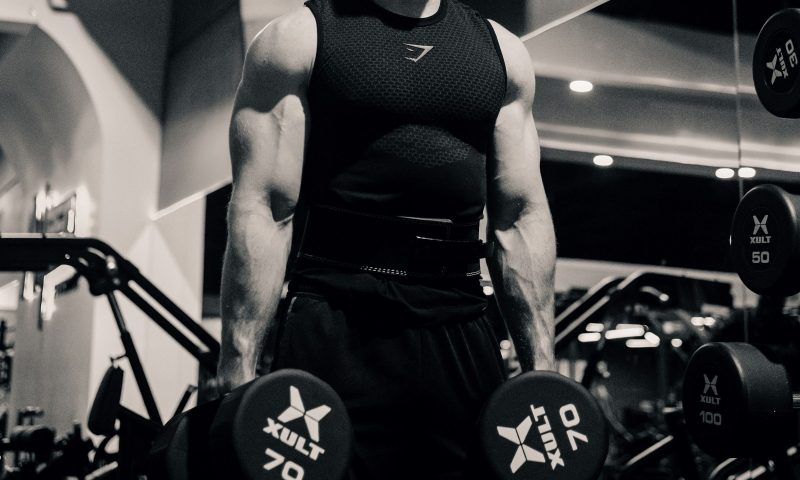As a personal trainer and gym enthusiast, I am always around heavy lifters who claim they can’t go without a weightlifting belt. Belts are known for helping stabilize you while chasing a deadlift or squat PR, but is it necessary? And what do weightlifting belts do exactly?
What do weightlifting belts do?

Weightlifting belts are tools designed to provide support during heavy lifting exercises. According to a ScienceDirect study, “Wearing abdominal belts raises intra-muscular pressure of the erector spinae muscles and appears to stiffen the trunk. Assuming that increased intra-muscular pressure of the erector spinae muscles stabilizes the lumbar spine, wearing abdominal belts may contribute to the stabilization during lifting exertions.”
A weightlifting belt does not directly lift the weight for you or make you stronger; instead, it acts as a cue to engage your core muscles more effectively. Proper breathing and bracing against the belt are essential for maximizing its effectiveness.
Different styles of belts are available, including tapered and uniform-width designs, each catering to different types of lifts. While weightlifting belts are often associated with powerlifting and bodybuilding, they are also used in Olympic lifting and general strength training. Correct use of a belt starts with understanding its role in supporting technique.
What are the benefits of weightlifting belts?

Increased core stability
A belt helps increase intra-abdominal pressure, which acts like a natural brace for your core. This added support makes it easier to maintain proper form during heavy lifts and reduces the risk of your spine collapsing under load.
Improved lifting performance
By stabilizing the core and spine, a weightlifting belt can help you lift heavier weights more safely and effectively. Many lifters find that they can perform more reps or add a small amount of weight to their lifts when wearing a belt.
Better body awareness
Wearing a belt encourages proper bracing techniques, making you more aware of how to engage your core muscles during a lift. Over time, this can lead to better overall lifting mechanics, even when you’re not wearing the belt.
How heavy do you need to lift to wear a weightlifting belt?

There is no exact weight where a belt becomes necessary, but most lifters start using one when lifting around 80% or more of their one-rep max. At these heavier loads, maintaining strong core stability becomes more difficult, and the added support of a belt can make a difference. If you are still mastering basic form or lifting lighter weights, you likely don’t need a belt yet.
Weightlifting belts are most useful for heavy, compound exercises that place significant strain on the spine. These include squats, deadlifts, overhead presses, and barbell rows. Movements where the torso needs to stay rigid against heavy resistance are ideal situations to use a belt. For example, some people are tempted to round their lower back at the start of a heavy deadlift; a belt can help discourage this and prevent injury.
However, for exercises like bicep curls, lunges, or most machines, a belt is usually unnecessary. Knowing when to use a belt ensures you get its benefits without relying on it too much.
How do you properly wear a weightlifting belt?

To wear a weightlifting belt properly, position it around your waist, covering your lower back and your core. The belt should sit just above your hipbones and below your rib cage, not too high on your stomach or too low on your hips. Tighten the belt so that it feels snug but still allows you to take a full breath into your belly.
Before lifting, take a deep breath and brace your core by pushing your abdomen outward against the belt. This pressure is what creates stability, not simply the belt being tight. Ensure the belt is secure enough to prevent shifting during your lift, but not so tight that it restricts your breathing or movement.
Tips for purchasing the best weightlifting belt

When selecting a weightlifting belt, begin by examining the material. Leather belts are the most durable and provide the most support, while nylon belts offer more flexibility and comfort for dynamic movements. You typically want to decide based on the type of lifting you plan to do.
Next, consider the width and thickness. A uniform-width belt, typically around four inches around the entire belt, is ideal for powerlifting because it offers consistent support. Tapered belts, which are narrower in the front, are often preferred for Olympic lifting or general fitness.
Pay attention to the closure system as well. Prong belts, lever belts, and Velcro belts all have different levels of security and convenience. Choose one that fits your training style and comfort level. Finally, always check sizing charts carefully — belts are meant to fit snugly around your waist, not your hips or pant size.
Frequently asked questions

What are the disadvantages of a weightlifting belt?
Relying too much on a weightlifting belt can prevent you from developing natural core strength. Belts can also be uncomfortable if worn improperly and may restrict breathing if tightened too much. Additionally, they are not necessary for all exercises and can sometimes give a false sense of security.
Is it better to squat with or without a belt?
It depends on your goals and experience level. Squatting with a belt can help you lift heavier weights by improving core stability. However, squatting without a belt builds natural core strength. Many lifters train both ways, using a belt only for their heaviest sets or max attempts.
What happens if you lift weights without a belt?
Lifting weights without a belt places more demand on your core muscles for stability and support. While this can help build natural strength over time, it may increase the risk of injury when lifting heavy weights, particularly during compound movements such as squats and deadlifts. Keep in mind that proper form is always key.




